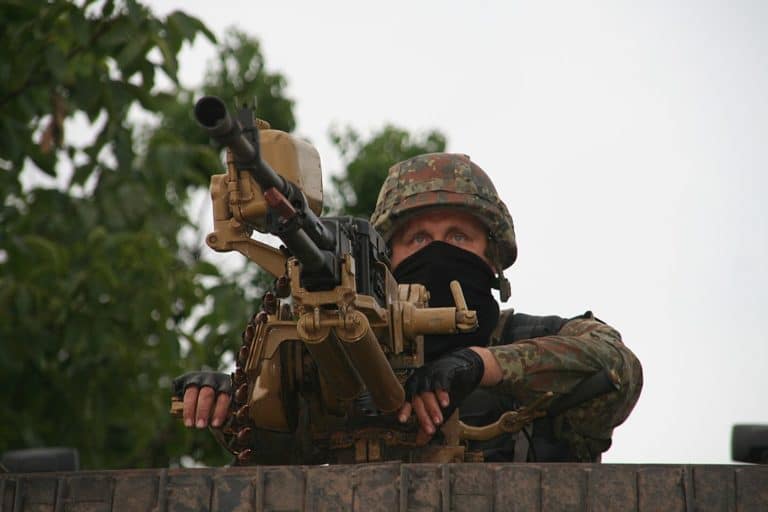
When Russian President Vladimir Putin declared war on Ukraine last Thursday, he invoked ‘Nazism in Ukraine’ as justification – a claim which the rest of the world categorically rejects.
Russian media has repeatedly sought to portray Ukraine as being aligned with Nazism and Putin has been making Nazi claims against Ukraine since at least 2014.
Putin here is invoking "fighting antisemitism" in Ukraine as a reason for the hostilities. pic.twitter.com/bXFL9TVGgV
— Johnny Kunza (@johnkunza) February 4, 2022
Ukraine is a democratic country whose president, Volodymyr Zelensky, was elected in a free and fair election in which he amassed more than 70% of the vote. Zelensky is Jewish and lost family in the Holocaust.
I appreciate Russia’s declared goal of “de-Nazifying” Ukraine with its *checks notes* Jewish president.
— Avi Mayer (@AviMayer) February 24, 2022
The country is far from a ‘Nazi state.’ In fact, the Pew Research Center found Ukraine to be the most accepting of Jews among all Central and Eastern European countries in a 2018 study.
However, White Nationalism combined with a growing Far-Right political movement are both still a problem in Ukraine.
The difference between the Azov Movement and Azov Regiment

The most known neo-Nazi group on Ukraine’s far right is the Azov Movement. The White Nationalist movement grew out of the Azov Regiment (originally a Battalion), formed in the chaos of war in early 2014 as an anti-Russia militia.
It was formed by a “ragtag group of far-right thugs, football hooligans and international hangers-on, including dozens of Russian citizens,” said Michael Colborne, a journalist and expert on the Ukrainian far right.
In 2014, the Azov Regiment, which today functions as an armed wing of the broader Azov Movement, became an official unit of Ukraine’s National Guard. At that point, they had garnered public support as they fought Russia from taking Mariupol, an eastern port city.
Neo-Nazi ties
Azov’s Nazi ties are not subtle.
Their emblem, which Azov soldiers wear on their uniforms feature a ‘Wolfsangel’ and ‘Black Sun,’ two symbols associated with Nazi Germany and neo-Nazi’s today.
In 2010, the battalion’s first commander and a former Ukrainian parliamentarian, Andriy Biletsky, said he believed Ukraine’s national purpose should be to “lead the white races of the world in a final crusade … against Semite-led Untermenschen [subhumans].”
In recent years, the Azov Regiment has downplayed its neo-Nazi affiliations to avoid being defined as a “Foreign Terrorist Organization.”
Among those who have trained with Azov are several of the men responsible for fomenting violence at the Unite the Right rally in Charlottesville, Virginia, according to a joint opinion piece in the New York Times by former Democratic congressman Max Rose and former FBI agent Ali Soufan.
“It’s more a brand than a party, a polished PR-focused outfit that isn’t above coyly referencing the so-called “14 words”, a white supremacist slogan,” said Corborne, who wrote a book on the subject.
“The Azov Movement tries to be a one-stop shop for all things far right. There’s also a bevy of loosely affiliated but more extreme subgroups under its umbrella as well, including open neo-Nazis who praise and promote violence.”
How influential are they?

Today, the movement’s most public face is the National Corps political party which has minimal electoral support.
The party won barely 2% of the vote in a coalition with other far-right parties in parliamentary elections in 2019. Estimates of membership are around 10,000 members, according to Corborne.
They’ve been able to take advantage of general ‘patriotism’ in Ukraine since Russian aggression began in 2014, explained Corborne.
“The movement has used the current crisis to try and make itself appear more mainstream, hosting public civil defence training sessions and positioning itself as the force that can best protect Ukraine from its enemies, particularly in the case of a full-scale invasion,” he wrote.
Its leaders play up their status as veterans “insulating themselves from criticism as mere ‘patriots’ who voluntarily took up arms in the earliest days of the war when Ukraine’s military was a shambles.”
Banned from Facebook
In 2019, Facebook released its “Dangerous Individuals and Organizations” policy which prevents “organizations or individuals that proclaim a violent mission or are engaged in violence to have a presence on Facebook.”
Under the policy, praising the Azov Movement was banned, classifying Azov alongside others such as the Ku Klux Klan and the Islamic State.
Last week, Facebook reviewed its policy in relation to Russia’s war on Ukraine and changed it, according to Business Insider.
“For the time being, we are making a narrow exception for praise of the Azov Regiment strictly in the context of defending Ukraine, or in their role as part of the Ukraine National Guard,” a spokesperson from Facebook’s parent company, Meta, told Insider.
“But we are continuing to ban all hate speech, hate symbolism, praise of violence, generic praise, support, or representation of the Azov Regiment, and any other content that violates our community standards.”
The battalion itself will still be banned from using Facebook to publish posts or recruit members and images of its uniform and banners will still be banned as hate symbols.
Some of the phrases Facebook now deems acceptable include “Azov Movement volunteers are real heroes, they are a much needed support to our national guard”; “We are under attack. Azov has been courageously defending our town for the last 6 hours”; and “I think Azov is playing a patriotic role during this crisis,” according to The Intercept.
‘Not an excuse to legitimize Putin’
The Azov Movement is frequently cited by people who want to legitimize Russia’s false claims that Ukraine is a ‘Nazi state.’
“The Azov movement… is being more frequently dropped online by people who want to give Putin a free pass to do what he wants in Ukraine,” Corborne wrote. “It doesn’t in any way justify the actions of the Russian president.”
Talking about the far right as an issue in Ukraine has been taboo in the past.
“There’s long been a real fear in Ukraine of feeding into Kremlin propaganda by talking about the far right,” Corborne said. “But pretending the far right isn’t an issue won’t make it go away.”
Originally Published Mar 1, 2022 12:02AM EST


